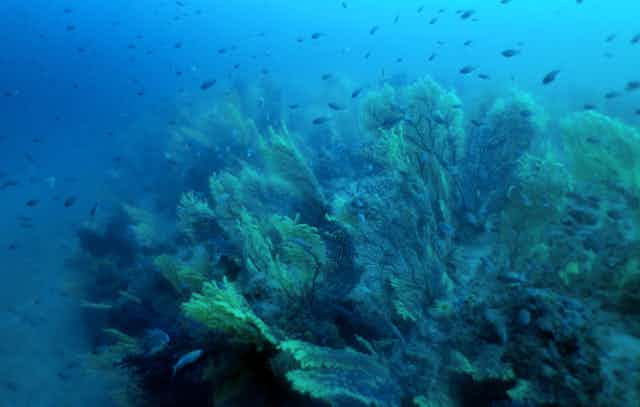Gorgonians are an order of soft corals that belong to the large group of Cnidaria, which also includes hard corals, sea anemones, jellyfish and many other species. Gorgonians colonise the seabed all over the world, from shallow coastal areas to deep sea canyons, temperate and tropical areas to polar zones.
Gorgonians’ skeleton can be soft or rigid, horny or calcareous. These organisms can form dense communities that structure the seabed, constituting “animal forests” offering a refuge to a myriad of marine species.
One of the most beautiful underwater landscapes in the Mediterranean
In the Mediterranean, a total of five main species of gorgonians can be found living up to 100 metres below the surface. One of them, Paramuricea clavata, forms remarkable populations both by its red colours and the size of its colonies, which can exceed 1 metre in height.
It is one of the most beautiful underwater landscapes in the western Mediterranean, popular among both amateur divers and underwater photographers. The colonies are either male or female and all originate from the planula, a free-swimming or crawling larva type common among Cnidaria. Egg-shaped, the planula uses hairlike projections called cilia to propel itself through the water. It grows slowly (2 to 3 cm/year at most) and can live several decades.

“Animal forests” weakened by human activities…
Purple gorgonian beds, like those of other gorgonians, are fragile and vulnerable to human activities in coastal areas. In the Mediterranean, these populations are also regularly affected by the impact of climate change.
Fishing nets and anchors can tear off the fragile colonies or cause injury (necrosis) to the living tissue covering their horny skeletons. Creatures that live on top of other organisms – known as epibion organisms – then proceed to colonise the beds’ exposed areas, threatening the colony’s survival.
Excessive input of sediment in marine environment – referred to as hypersedimentation and linked to coastal constructions and the changes of the courses of rivers – is also a threat to the populations of gorgonians.
Although they have been spared from warming Mediterranean waters, the Paramuricea clavata are locally impacted by fishing and above all by recreational fishing. The vast rock shelf colonised by these giant gorgonians is home to scores of sea breams in the autumn, which themselves are prized by amateur fishermen.
Up to 180 boats were counted on 29 October 2016 during the sea bream reproduction period. Anchors and fishing lines uprooted many giant colonies. It therefore appears essential to control visitor numbers in this conservation area if we are to enable this unique natural heritage to coexist with human activity.

… and by climate change
Human activities in the coastal area are not the only danger faced by gorgonians. In recent decades, climate change has caused the strong wind on the Provencal coast known as the Mistral to weaken during increasingly long periods. This, in turn, has provoked thermal anomalies in the water column.
The result of this is the submergence of the surface warm water layers (temperature >22 °C) for stretches of several weeks. The latter can be fatal to the gorgonian populations, which are usually exposed to cooler temperatures (around 13 to 15 °C).

In 1999, a vast thermal anomaly affected gorgonian populations in the western Mediterranean stretching from Spain to Italy. Apart from gorgonians, about 20 other species (sponges, bivalve molluscs, bryozoans, ascidians) were also affected. The anomaly was characterised by the presence of a column of warm water (23 to 24°C) at a depth ranging from 40 to 60 metres for a month. Other events of this type were then observed in 2003, 2006 and 2009, affecting the gorgonians to a greater or lesser extent.
Factors such as the gorgonians’ genetic makeup or microbiota will dictate how they fare in the face of heat stresses. In the coming decades, significant climatic changes are expected to impact upon these species’ location and distribution.
Discovering a unique deep-sea community
Although gorgonian populations in the Mediterranean are well researched down to 50 metres, little is known about those farther below. A unique settlement was discovered a few decades ago off the Côte bleue (northern bay of Marseille) at a depth of 50 to 60 metres. This settlement occupies a vast rock shelf extending over nearly 2,500 hectares.
It is characterised by a high density of gorgonians, but above all by the presence of giant colonies. Hovering between 1.50 and 1.80 metres, these corals are probably around a century old.

Recent studies have sought to explain the reasons behind the species’ gigantism and tightly knit networks (REFUCLIM programme) and distribution (GIGOR programme). The results seem to show that, apart from their morphology, these gorgonians are genetically unique and clearly distinct from those found at shallower depths.
The environment surrounding them is unique. Not only are the gorgonians regularly subjected to strong inputs of organic matter linked to the proximity of the Rhône’s mouth, but the bottom currents are generally weak. The combination of these two parameters allows the gorgonians to reach exceptional sizes.
One of the issues at stake is that these deep settlements can constitute refuge populations, which are relatively spared from global warming, making them all the more important for the species’ survival.
The study of deep-sea gorgonian populations is a major area of research in the years to come, not only to initiate appropriate protection measures, but also to better understand their connections with the populations inhabiting the sea’s shallower depths.


